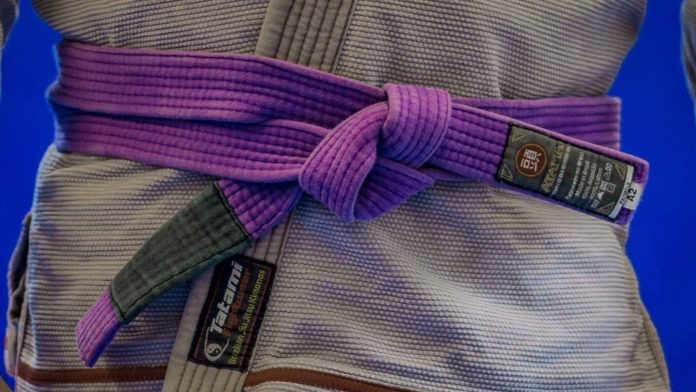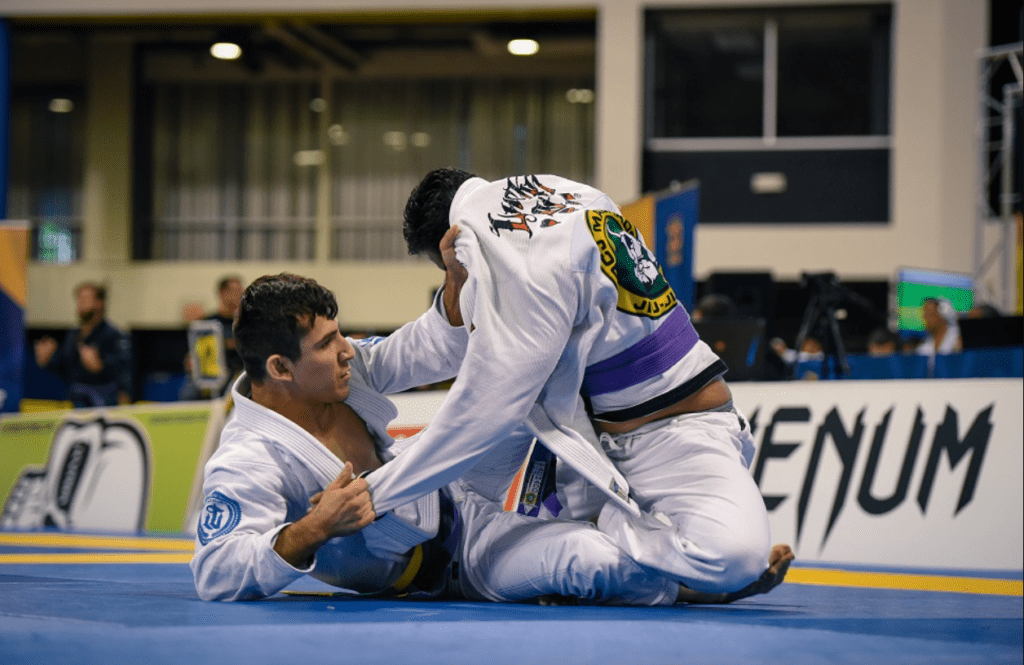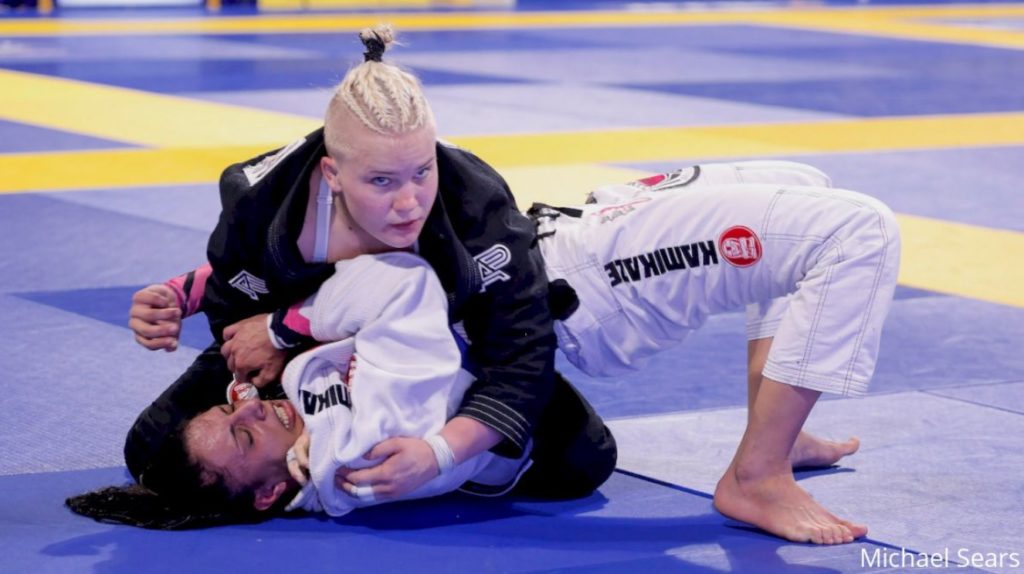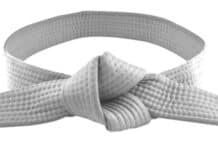
So, you’re hoping to reach the next level in BJJ. You’ve proven that you can stick with it, you made it through the white belt “initiation period”, and then you did not quit as a blue belt, proving all those memes wrong. Great job. But now, you’re wondering when your purple belt is going to come, to further reinforce the fact that you’re serious about Jiu-Jitsu, whether it is to yourself or to others. Well, there are certain BJJ purple belt requirements that are expected out of everyone, regardless of which academy they train at.
With most academies around the world having their own version of a curriculum, and professors having different belt promotion standards there’s no unified system that clearly defines when one is ready to get their next belt. However, there are certain things that specific BJJ belts should be supposed to do and there’s no need really to put it on paper. That said, BJJ purple belt requirements are quite clear, similar to blue belt requirements. Let’s systematize them in a universal way.
BJJ Purple Belt – The Most Fun Time In Jiu-Jitsu
Becoming a purple belt is a serious thing. Nowadays, BJJ is spread so much that plenty of people make it to the blue belt. In fact, I’d even go as far as saying that the bar for most belts, and especially the blue belt has been brought quite a bit lower than a decade ago. But that’s progress, I guess. As long as the fundamental belt requirements are clear, promoting someone is not an issue.
To get a purple belt, though, any grappler needs to actually have quite a bit of knowledge and start developing an understanding of Jiu-Jitsu. BJJ purple belt requirements are a big step up from the blue belt requirements. The purple belt is a defining period of any grappler’s journey. It is a time when things start to make sense, and the individual game develops. As someone once said: “a purple belt knows all the techniques a black belt does – it is the experience that makes the difference”. As a blue belt looking to become a purple belt, you’re not quite there, but you should be close.
In fact, I believe that promoting someone to a purple belt should only be done when they’re already at the purple belt level. That means that when someone is ready to get a purple belt, they should still wait a little bit longer so that when they get their belt they already have some of the beginning markings of a purple belt. As per IBJJF guidelines, the minimum age for getting a purple belt is 16. Furthermore, the “average” period peoples spend at blue is about 2 years which I think is appropriate, given the vastness of BJJ purple belt requirements.
BJJ Purple Belt Requirements– An Overview

One thing that really helps to accumulate enough knowledge to progress to a purple belt is the frequency f training. If a blue belt trains once, or even twice a week, it’ll take significantly more time for them to reach the next level. Three times a week without missing classes is a bare minimum to be able to have hopes of fulfilling almost BJJ purple belt requirements within the “average” two year period. Training more than three times a week will accelerate how fast you’re ready to get to the next level.
That said, BJJ purple belt requirements are not just technical. It takes a lot more than just a collection of techniques to become a purple belt. While it is a marking of a purple belt to have a cohesive game that flows together, tailored individually to one’s needs, glimpses of that should be apparent at the blue belt. In other words, your mindset, technical knowledge, understanding of BJJ, as well as some specific behavioral aspects should all be at the purple belt level before you get the belt. This is a requirement that is specific to the purple belt, given the importance of that belt in BJJ.
Detailed Breakdown Of BJJ Purple Belt Requirements
What exactly is expected of you in order for that coveted purple belt promotion? Well, to be honest, a lot. For starters, you will need to demonstrate that you don’t just have several moves from any given position, but that you also know how to connect everything together. That means that you should not just be bel to string together different submissions, but also transition between the main positions of Jiu-Jitsu. Those include guard, mount, side control, back control, knee on belly, and turtle. In order to even hope for a purple belt, you should also be comfortable from both your back and when in someone’s open or closed guard.
From the feet, being able to take someone down in at least three different ways is a big aspect of BJJ purple belt requirements. Guard pulls, as much as I don’t like them, are also mandatory in a purple belt’s arsenal. Actually, there should be more options than just pulling a closed guard.
In most gyms around the world, the self-defense aspect of the sport is less and less in focus as people go higher in rank. Whether or not this is justified, is a subject for another day. For now, let’s just say that a purple belt in BJJ needs to be able to have the composure for staying calm faced with strikes, as well as being able to take a fight down into a controlled position.
1. Movement
One thing that is true of all purple belts is that when you see two of them fight or roll, they look like cats. There’s a smooth movement that might go on the duration of around without any breaks. They seem to be gliding around when on top and spinning and shrimping when in guard. That has to do with how they perceive transitional movements in-between positions, which is exactly what blue belts need to figure out.

A high blue blets should also be able to do so more advanced BJ specific motions, like Granby rolls, Imanari rolls, inversions, backsteps, sit-outs, and similar movements are definitely staples of a purple belt’s game. they are, however, things that students learn at blue belt and then get to use as purple belts.
2. Bottom Game
From the bottom, BJJ purple belt requirements spread to much more than just the closed guard, and an open guard variation or two. A blue belt should be comfortable from their back, having at least a couple of closed guard variations and at least three (preferably more) open guards. Moreover, this is the time when the half guard comes into focus, especially from the bottom. The reason for this is that half guard is the perfect checkpoint for all escape attempts, which are a mark of bleu belts. When those escapes to half guard become successful, that is a clear sign of a purple belt, and understanding half guard plays an obviously huge role.
-
Closed Guard
From the closed guard, retention remains the number one priority for any belt. If your guard gets passed, all your attacking tools will be useless. As a blue belt, though, you’ll need to be able to stay in guard against different levels of guard opening, ranging between standing, kneeling, and Sao Paolo-style passing.
Moreover, variations of the closed guard are also key to fulfilling BJJ purple belt requirements. At least two variations (basic closed guard and one more) are necessary. Here are some ideas:
Attacking from the closed guard is also not as straightforward as in the beginning. IF you want to be a purple belt, your attacks will have to go together. That means that when you get an armbar, for example, you’ll need to be aware of how to get into a triangle from there, as well as using the position to sweep. We’ll talk specifically about submissions, later on, but sweeping with a submission form closed guard is definitely a clear mark of a BJJ purple belt.
- Flower sweep [Read More]
- Overhead sweeps [Read More]
- 100% sweep [Read More]
- Guillotine Sweeps [Read More]
-
Open Guards
There’s no point in having just one guard in Jiu-Jitsu, especially in the context of open guard. As a blue belt, you’ll start experimenting with gaurs, but it will be purple when you really discover what you love to play. BJJ purple belt requirements demand that you know how to work from at least a few different types of open guards. The specialization will come later.
- De la Riva guard(s) – regular and reverse De la Riva [Read More]
- Spider guard [Read More]
- X guard(s) – Full X-Guard and the Single Leg X-Guard [Read More]
-
Open Guard Attacks

The half guard is a huge part of a blue belt’s game. It is something white belts dabble in, but it only starts to make sense at blue belt. The half guard nowadays has so many variations that it would be difficult to pinpoint the one that best fits BJJ purple belt requirements. I’d go for the Z-guard as it offers the highest percentage attacks, easy retention, and works in Gi and No-Gi. Again, retention is the number one focus from the half guard.
- Half guard sweeps (at last two) [Read More]
- Half guard submissions (Loop choke and Kimura) [Read More]
3. Top Game
If purple belts are known for experimenting with guards, they must then be quite comfortable passing the guard. And they are, mainly because it is something that they developed at blue belt, as part of the BJJ purple belt requirements. Apart from passing, top position maintenance and moving in between all major top positions is also a must for any purple belt.
Simply put, a purple belt must know at least a few side control variations, a few knee on belly variations, the main levels of the mount, as well as back control variations, and be able to move between them. Once again, the focus is on transitioning.
-
Side Control
Form side control, it is all about staying in side control, as long as you see fit before moving on. Since saying in just one side control variation is not going to help you stay there, you’ll need not just different options, but ways of connecting them with each other as well. Knowing these ticks off a big box of the BJJ purple belt requirements.
The Mount
The mount might seem simple but there are so many different little details that make it actually work for people. If you want to kill off bridge and knee and elbow escapes, you’ll need to know how to move up the mount. That means you’ll need to be comfortable low, high and S-mount, and of course, know how to transition in between them.
Back Control
The back is something that purple belts really call home. IN order to e able to have fun with the different purple belt level attacks from the back, though, you’ll need to understand how to stay on the back. In terms of BJJ purple belt requirements, being able to stay on someone’s back for an entire round is what matters. Retention is key, and it will take time to really master, but what else are you going to do as a blue belt? Figuring out how body triangles work and how to stitch the harness grips from side to side are also important things to learn before purple belt.
The knee on belly position is actually much more diverse than people give it credit for. it is not just a spot to hang out for a few seconds. there’s a reason why this position is worth 2 points in competition – it provides control and with it, plenty of attacking options. That said, alternating between a knee on belly position that puts people under crazy pressure, and the one that allows you to transition further along the hierarchy is one of the most important BJJ purple belt requirements.
Breaking down the turtle with attacks that lead somewhere is another characteristic of purple belts. Knowing the directions in which you can do it, along with the positions that will allow you t dominate an opponent once you break their turtle and prevent them from re-turtling are the things to focus on as a blue belt.
Rolling into back control, figuring out how the kneeling front headlock works as well as using some wrestling staples like Nelsons and chicken wings to break the turtle down are a must.
Getting past the legs is never an easy task in Jiu-Jitsu, at any belt level. BJJ purple belt requirements for getting past the legs must involve at least one option of there of the four directions of passing – under the legs, around the legs, and through the legs. Going over the legs is something that purple belts need to learn later on. Understanding pressure passing and lose passing is also important at that level.
- Sao-Paulo Pass [Read More]
- Folding Pass [Read More]
- Stack Pass [Read More]
- Leg Drag Pass [Read More]
- Over Under Pass [Read More]
- Knee Slice Pass [Read More]
4. Standing
From the feet, BJJ purple belt requirements are all about direction. You need to be able to throw or take people down in every possible direction, using both upper and lower body takedowns. Moreover, you’ll need to take people down in both Gi and No-Gi. Also, guard pulls become much more important, as you need to know how to get into open and half guard form standing, as well as knowing how to pull the closed guard.
- Half Guard pull [Read More]
- Open Guard pull [Read More]
- Double leg takedown (different finishes) [Read More]
- Single leg / High crotch takedown (different finishes) [Read More]
- Sumi Gaeshi / Tomoe Nage [Read More]
- Front Headlock Snapdowns [Read More]
- Kata Guruma [Read More]
- Hiza Guruma [Read More]
5. Submissions
A blue belt looking to progress to purple needs to know submissions. And lots of them. In fact, right before you get your purple belt, you should already be a specialist in at least one choke, one leg lock, and one arm lock, preferably more. being a specialist means being able to catch everyone at your level, and oftentimes people that are above you in rank with them. That, however, does not exclude other submissions. Quite the contrary, blue belt is when you mess around with as many different submission techniques as you can!
- Triangle choke(s) (from, guard, mount, and back) [Read More]
- Armlocks (from closed guard, half guard, and the mount) [Read More]
- Ezekiel choke (from the mount) [Read More]
- Loop Choke (from half guard) [Read More]
- Arm triangle (from the back) [Read More]
- Toe Hold [Read More]
- Kneebar [Read More]
- Bow and arrow choke [Read More]
- Wristlocks (from both closed guard and the mount) [Read More]
- Darce choke [Read More]
6. Escapes

One main thing from any defensive position for blue belts is not allowing the other person to submit you.
- Side control bottom (Ghost escape, getting half guard, rollover escapes) [Read More]
- Mount bottom (bump escape, escaping into Ashi Garami, Alcatraz escapes)[Read More]
- Back Control bottom (Body triangle escape, grip fighting, escape to turtle)[Read More]
- Turtle bottom (rolling out, getting half guard, frame escapes) [Read More]
- Knee on Belly (escape to leg locks, escape to half guard) [Read More]
7. Mindset
A blue belt is a very difficult period in terms of BJJ mentality. this is the time when you need to tame your ego, at least the most glaringly obvious aspects of it. This has to do a lot more with the mental approach to the game than the physical one. In terms of BJJ purple belt requirements, you need to have an open game, which is something i see blue blets struggling with the most.
Namely, blue belts get so good at defending, and eventually escaping things, that they oftentimes become very passive. While there are merits and logic to this type of game, progress requires going on the offensive as well, which means you should abandon the safety of your sweet spots, especially against higher belts. Overcoming this particular hurdle is the biggest mindset BJJ purple belt requirement of them all. Just go on the offense yourself and to worry about what will happen – that’s how you’ll learn that three’s always bigger and “badder” wolf in the pack.
8. Self-Defense
- Strike evasion (on the ground and standing) [Read More]
- Quick takedowns (on the ground and standing) [Read More]
- Standing and ground control [Read More]
9. Drills And Rolling
Rolling-wise, BJJ purple belt requirements are actually easy – know how to roll. it is not about what you do, how much you accomplish, or anything of the sort. You’ll just need to learn how to roll first and foremost – no spazzing, trying to be technical, and rolling slightly differently with different major categories of people as to accommodate them and yourself.
Learning different types of rolling also happens at blue belt. Slow rolling is a big one, and it is an important aspect of a purple belt’s game. Without at least understanding how slow rolling works, you’ll hardly be able to progress to the purple belt. this is what makes all those transitions seem simple and smooth.
Specific sparring is a huge aspect of rolling as well. In fact, it is an aspect of both rolling and drilling for blue/purple belts. It is better to set up drills in scenarios, where people can see the context of the entire move they’re working on. Specific positional sparring offers just that, as well as the chance to control the intensity and the level of resistance.
The final aspect of BJJ purple belt requirements in terms of rolling has to do with responsibility. As a blue and soon to be a purple belt, you need to know how to roll with those that are new, injured, older, from the other sex, etc. As a purple belt, you’ll have to do teaching rolls as well, with people that won’t offer you a challenge, but the roll with you will be extremely valuable to them. understanding your rolling responsibilities in the gym is a huge step forward for any grappler.
10. Behavior
The way people act on the mass is always something instructors monitor. However, as you progress through the ranks, the expectations in terms of overall behavior rise. In fact, they’re a part of the requirements for every belt. in terms of BJJ purple belt requirements, it comes down to the example you set for others, your dedication to the sport, and giving back to the art of Jiu-Jitsu.
In terms of being an example, expect that new students will always look up to the belt that is within their reach. That means that blue belts are often the most reliable example for white belts, as they know that is the next level. How you conduct yourself in class, from warm-ups to rolling, and in the changing room will affect the way they behave as well. As you get to the purple belt you’ll have even more people looking up so acting right is a big deal. Really!
At purple belt, many people start to dabble in teaching, whether it is helping coaches out in fundamentals groups or taking up a role in kids groups. Knowing how to teach is a huge thing in Jiu-Jitsu and you definitely need to know how to do it, if that is what you want. While this is one of the optional requirements at this point, it is still something to start considering.
11. Optional
Finally, a few more aspects of Jiu-Jitsu fall under BJJ purple belt requirements. You already know that competing is not a condition for progression in BJJ. However, many people decide to do it anyway. Competing in Jiu-Jitsu is fun and as a blue belt, you’ll run into probably the biggest pool of opponents possible. If you decide to compete, you’ll need to devise a game plan. Moreover, you’ll need to have a gas tank to help you execute it.
– Competing
As a blue belt, competing comes down to two things- having a game plan, and listening to your corner. As a white belt, it is mostly about trying to survive by using the few tools you have. At the blue belt level, you’ll need a game plan for every position. You’ll also need to factor in plenty of other things, like scrambles and transitions. In fact, the moment you start bringing tactics into it, you’re ready to start testing purple belt competition waters.
– Conditioning
For competitors, conditioning is mandatory after the white belt level. There’s just no way around it, given that everyone else will be doing it, especially in adult divisions. The focus at this point should be on cardio and conditioning rather than strength. As a purple belt, you’ll need to move a lot and your conditioning needs to reflect that. Be careful and well-informed when it comes to choosing your conditioning plan though. It needs to fit you.
Gi vs. No-Gi BJJ Purple Belt Requirements
Let’s discuss something that I also consider to be among the BJJ purple belt requirements, at least in my gym. While people might not agree, I do think that overall knowledge of Jiu-Jitsu is a must for everyone, at least until they reach back belt and can then decide to specialize in something. That means Gi, No-Gi, and self-defense all have a part to play.
In terms of training without the Gi, I think it is a must if someone wants to be a purple belt. It doesn’t mean people have to compete in No-Gi or spend ample amounts of time training it. However, being able to roll without a Gi is an important aspect of Jiu-Jitsu. That means knowing grip fighting, submissions, positional details, escapes, etc in a No-Gi setting. As similar as this is, it is far from being the same as in Gi, which means there’s a lot to learn.
My two cents are that even people that rain exclusively No-gi should be working with the gi as well. It is ok to focus on one or the other, but there has to be at least rudimentary knowledge of the alternative. And that knowledge needs to be appropriate to the belt rank of a person.
Conclusion
BJJ purple belt requirements are probably the most complicated of them all. Purple belt marks a huge transition from being someone who trains, to someone who embraces the BJJ lifestyle. As such, they tend to encompass a lot of different things. They are, however, more than worth it! Coming into the purple belt ready for the challenges it brings is way better than coming in unprepared. While the requirements above are far from everything you need to be a purple belt, they’re universal for everyone. Any person that fulfills them all is already at purple belt level, regardless of what hangs at their waist. Wearing a purple belt you can say that you’re very good in Jiu-Jitsu and even able to compete at a high level in Pro and Advanced tournaments together with other brown and black belts and those who got their Jiu-Jitsu black belts very fast.
Related Articles
- BJJ Purple Belt: The Annoying “Know-It-All” Student
- Jiu-Jitsu Belts Explained: The Ultimate BJJ Belts Guide
- Purple Belt – The time when Jiu-Jitsu starts to make sense
- Blue Belt Requirements and Curriculum











































